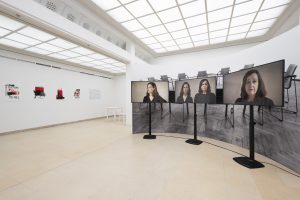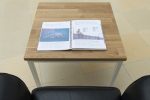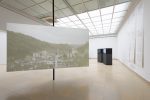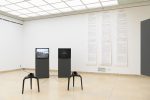IDENTITY IS UNCERTAINTY #2

IDENTITY
IS UNCERTAINTY #2
<Trauma><Art><Activism><Revolution>
Anna Dasović
KURS (Mirjana Radovanović & Miloš Miletić)
Lena Ditte Nissen
Airi Triisberg
curated by Andrei Siclodi
RE-OPENING 10.02. – 17.04.2021
The exhibition Identity is Uncertainty #2 <Trauma><Art><Activism><Revolution>shows new works developed in Innsbruck by participants in the Fellowship Program for Art and Theory at Künstlerhaus Büchsenhausen 2019-20. Anna DASOVIĆ, KURS (Mirjana Radovanović and Miloš Miletić), Lena Ditte NISSEN and Airi TRIISBERG focused on projects addressing constructions of identity that are of constituent significance for our present. The foundations of these identity constructions are to be found in the humus of (Post)National Socialist and (Post)Communist historical events: The military construct of the “Other” in the course of the UN presence during the Yugoslav wars in the 1990s, activist biographies in Eastern Europe after the fall of the Berlin Wall, but also the National Socialist ideology and its subcutaneous persistence to the present day, as well as its counterpart in Yugoslavia – the partisan movement and its culture – were topics and projects‘ onsets of the Fellows’ theoretical and artistic working proposals.
As the numbering implies, this show is the second part of an analysis that focuses the themes listed above – in the format of an exhibition. Identity is Uncertainty #1: On the Socio-Historical Constitution of the Present , on display in the Künstlerhaus Büchsenhausen during fall/winter 2019-20, deliberately evoked in its subtitle the wording of a reference book title – a book, however, that neither existed nor was planned. The subtitle intended to emphasize rather the discursive claim of an artistic practice with a socio-critical connotation that questions common interpretations of political notions and, by this, also gives way to new knowledge insights, contributing to an altered understanding of our present time.
The current exhibition in the Kunstpavillon also pursues this discursive aspiration, which, this time, unfolds between the field of overcoming and beginning anew; and focuses on the productive examination of historically, yet only seemingly completed processes of overcoming the past, as well as the conceptualization of possible future scenarios that bring into focus the emancipatory liberation from prevailing androcentric hegemonies.
At the very beginning of the exhibition, visitors get caught up in the maelstrom of a debate. In front of a concave wall on which a picture of a large circle of chairs can be seen, the three-channel video installation Nehmt es, wie es ist (Accept it as it is) by Lena Ditte Nissen shows two women of different ages who address the audience, sometime together, sometime individually. At first, one cannot hear what they say; only the look in each of the viewer’s eyes reveals the directness of their address. With the headphones, however, the viewer witnesses a performance that is obviously dealing with the memories of a woman committed to National Socialist ideas. The memoirs of Lena Ditte Nissen’s grandmother, which were written in the 1960s for her own family and were never actually intended for publication, are central in this project. They are the grandmother’s recordings about the family’s escape from the Allies in 1945, and a description of her concern for the family and the fate of the Führer.
“’Accept it as it is’, is a sentence in my grandmother’s memoirs,” writes Lena Ditte Nissen. “But I will not follow this demand. On the contrary, I have decided to use these memoirs, to read them, to share them with others, to break them apart analytically, but under no circumstances will I accept them as they are. My grandmother was the daughter of Nanna Conti, the Reich’s headwoman of midwives, and the sister of Leo Conti, the Reich’s headman for health. She was born in 1902 to a nationalistically and anti-Semitically minded family, and even as a teenager she supported National Socialist ideologies.
Why does someone write a memoir at all? Is it to determine the narrative of his or her life, or to keep the prerogative of interpretation? Because one wants to communicate certain things – or withhold others?
In search of the non-articulated, I invited a group of people to discuss, during several sessions, the memoirs in depth led by a group analyst. These conversations form the polyphonic foundation for a series of artistic works that deal with the role of women in National Socialism from today’s perspective. It is not about historical reappraisal – I leave that to the historians – I am rather interested in what happens when we get indeed involved in these stories emotionally, what this involvement does to our perception of the present. In my opinion, it has to get personal.”
The narration in the video installation unfolds by this credo: for the purpose of an experimental cross-generational storyline, the actresses recite together excerpts from the memoirs while slipping into the roles of commentators on the left and right side respectively. The workshop participants’ statements with the group analyst are thus inserted between the grandmother’s reports, and illustrate the equally fragile and still unavoidable necessity of an unrestricted, taboo-free confrontation with what a right-wing totalitarian ideology is causing in each person and society as a whole.
From right-wing history to left-wing partisan struggle: In the left wing of the Kunstpavillon KURS (Mirjana Radovanović and Miloš Miletić) presents a series of graphic works titled Lessons on Defence, which were created in the context of the eponymous study on the cultural practices and the significance of culture within the Yugoslav Partisan Movement during the Second World War. This study was already conducted in 2016 and 2017, its results, however, were until now only published in Serbian. As part of the Büchsenhausen Fellowship, Radovanović and Miletić revised their text and edited it for an international readership – at last, this version has been translated into English and published in the book serie Büchs’n’Books – Art and Knowledge Production in Context with the additional support from the Rosa Luxemburg Foundation.
Now, why should one deal with a subject in 2020 that at first glance appears to be merely historical, and therefore relevant at best to subject-experts? Radovanović and Miletić argue with the potential topicality of knowledge that can be derived from the cultural practices in times of danger and uncertainty, yet characterized by a strong desire for social change, for today’s art and cultural production. Even though the partisan culture was the result of specific historical circumstances, KURS argues that then-practices could be productively applied today, not least because of the revisionist tendencies in the countries of former Yugoslavia – and surely elsewhere in Europe and the world – that instrumentalize culture under the pretext of lacking alternatives to capitalism as a means of depoliticizing anti-fascist movements. The imperative capability of such a confrontation with a past that, while not wholly erased from social consciousness, has undoubtedly been severely marginalized, also holds the possibility of a sharper perception of the commodification efforts to which art practices are currently subjected, and consequently the development of counter measurements.
With this in mind, the graphics presented in the exhibition are not only to be understood as aesthetic artefacts but rather as visualizations of content dealt with in the book. Visitors are invited to sit down at the white table and, while reading the book, to immerse into another time, when the struggle for survival for a new, egalitarian and prosperous social order was still at stake.
In the backroom of the Kunstpavillon, one encounters two contributions that, in a broader sense, could be described as activist-analytical. While Anna Dasović deals with the traces of the inglorious presence and deeds of the Dutch UN peacekeepers during the genocide against the Muslim population in Srebrenica in 1995, Airi Triisberg makes her research on activist biographies in Eastern Europe publicly available in the form of a diary.
Anna Dasović’s Before the fall there was no fall is an artistic-investigative long-term project that focuses on the question of how European histories of colonialism have produced West European, militarized masculinities and shaped the continent’s relationship to the (ethnical) “other” and its aesthetics.
The starting point of the examination is a collection of one hundred VHS tapes documenting exercises conducted by the Dutch military during the Yugoslav Wars in preparation for peacekeeping missions in the UN security zones of Srebrenica, Bihać, and the municipality of Sapna. The exercises staged in NATO camps in Germany and Belgium, created an ideological framework to help soldiers reflect on their relations with the people inside the security zones, but also with those who threatened to attack them. For this purpose, the Dutch Military involved soldiers formerly stationed in Bosnia and Herzegovina. On the one hand, these soldiers, transformed into actors, were supposed to rehearse scenarios from a given script. At the same time, they had to re-enact their perception of the people they had encountered in Bosnia and Herzegovina. Ultimately, this substitution process had the effect of reinforcing, if not exaggerating, the socially constructed representations of the “other”.
The VHS tapes had been stored in the archives of the Dutch Ministry of Defence for decades. With reference to the Dutch Freedom of Information Act, Dasović secured the release of these tapes after a legal tug-of-war that lasted for years. The video footage, as well as other documents, contextualize the origins and usage of the videos and form the raw material for a series of works that Dasović intends to develop in collaboration with other artists and theorists over the coming years.
The first two episodes of this project as well as a textual work that displays in three languages (Bosnian, English and German) excerpts from the “UN Manual”, the “Code of Conduct” for Dutch soldiers in Bosnia-Herzegovina are shown in the exhibition.
In Episode 01: Raw Material, Dasović assembles solely “raw material” from the VHS tapes in a two-channel video installation to reflect on identitarian role models that the “others” implicitly co-constitute. This “pedagogy” of dealing with “strangers” had to be internalized and implemented by young soldiers. Episode 02: Surfaces is an analytical video essay that juxtaposes the raw material from Episode 01 with the traces of Dutch blue helmets in the “UN Security Zone Srebrenica” 25 years later. Dasović asks: How did the hands of Dutch soldiers touch the surfaces of the buildings they were stationed? What do the left traces say about the Dutch army? How do the people in the exercise video conceptualize the culture of this army’s military doctrine, and what persistent traces will later be left on the UN compound in Srebrenica? The work suggests the hypothesis that the institutional racism of the Royal Netherlands Army is, at least to some extent, a late effect of the country’s colonial past.
The exhibition concludes with Airi Triisberg’s research diary. The diary collects visual materials documenting leftist and artistic activism in Belarus, Russia and Kazakhstan, in post-Soviet and post-socialist countries that share their past with the theorist’s context of life – Tallinn, Estonia. The research originated as part of a longer-term study of activist biographies in Eastern Europe. In the style of a do-it-yourself notebook, Triisberg designed the diary over nine months, between January and September 2020, included pasted photocopies, added hand notes, inserted text printouts and commented on them. The journal introduces little-known perspectives on the endeavors of left-wing activists in regions that fell under the rule of right-wing, authoritarian regimes after the collapse of the Soviet Union. Despite all, and due to the Soviet communist past, the general population rejects these left-wing movements out of hand. At the same time, it also documents contemporary historical events that happened just as the diary was being written, such as the people’s uprising after the elections in Belarus.
One of the diary’s emphasis is the visual evidence of feminist and queer groups’ activities in these countries, which have increased in popularity over the past ten years, but especially since 2015, spreading a new form of left-wing, non-parliamentary politics that, insofar as the ruling regimes do not radically repress them, show a potential of growth.
An almost universal characteristic unites most of the activism-images collected in the diary: usually, they do not show groups or collectives, but individual actors, isolated in one form or another from groups demonstrating protest insignia against social injustice or engaging in other political forms of protest. This should not necessarily be a discouragement, since this image is already familiar from another, Western context. It was a young schoolgirl, Greta Thunberg, who started like this – as a single climate striker. It demonstrates that, by personal commitment only, and only by leaving of one’s comfort zone, emancipatory social processes can be set in motion and thus contribute to improving everybody’s living conditions.
Andrei Siclodi
Curator




Andrei Siclodi